|
|
|
|
|
|
|
Achi-Kochi Japan
Showing many places to visit and foods to eat in Japan
|
|
|
|
|
|
|
|
|
|
|
|
|
Japan
> Shikoku region
> Shikoku Henro Pilgrimage
|
|
|
|
|
|
|
Shikoku Henro Pilgrimage
Shikoku ( Achi-Kochi Japan )
|
|
|
|
|
|
|
|
|
|
|
|
|
( "Achi-Kochi" in Japanese means "Here and there" in English. )
Shikoku Henro Pilgrimage
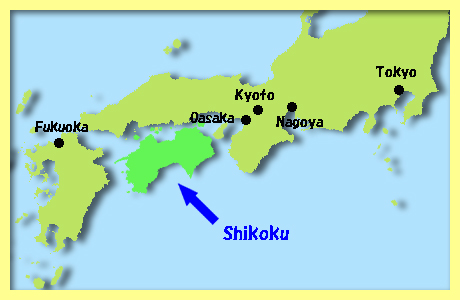
Shikoku Henro ( or O-Henro ) is a pilgrimage visiting 88 temples which are located in four prefectures in Shikoku Region. Shikoku Henro is referred in some documents written in the 12th century. It is said that the pilgrimage of the 88 temples was formed in the 16-17th century. In addition to the 88 temples, some pilgrims visit "Bangai" temples ( other sacred sites ). The first guidebook to Shikoku Henro was published in the 17th century.
|
Kukai ( Kobo Daishi )
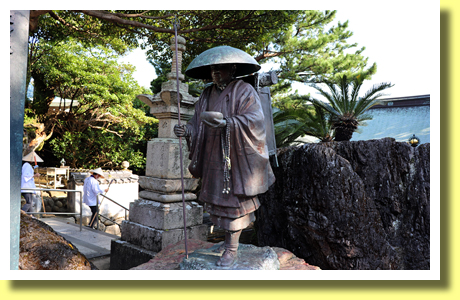
The 88 temples, which the Henro pilgrims visit, are related to Kukai ( Kobo Daishi ), one of the most famous Buddhist monks, born in Kagawa Prefecture in Shikoku Region in the 8th century ( ==> A History of Japan vol.1 Formation of Japan ). Some people say that Shikoku Henro is a pilgrimage following Kukai's footsteps. So pilgrims would see the statues of Kukai in most of the 88 temples such as in Kongofuku-ji Temple ( above ) located in Tosashimizu City, Kochi Prefecture.
It is Kukai who founded Koya-san Kongobu-ji Temple Complex in A.D.816, which is one of the largest Buddhism temple complexes as well as Hiei-zan Enryaku-ji Temple is. So many pilgrims visit Koya-san Kongobu-ji Temple Comple after their completion of Shikoku Henro Pilgrimage.
|
|
88 Temples

Though pilgrims could start at any of the 88 temples, many start at Temple No.1 Ryozen-ji, which is located in Naruto City, Tokushima Pref. The above photo shows inside the main hall of Ryozen-ji Temple.
Most of pilgrims visit the 88 temples in clockwise order. However there are some who visit them in reverse order. Among the 88 temples, 23 are located in Tokushima Pref., 16 in Kochi Pref., 26 in Ehime Pref., and 23 in Kagawa Pref.
"Shikoku", meaning four provinces, consists of Awa Province ( now Tokushima Pref.), Tosa Province ( now Kochi Pref.), Iyo Province ( now Ehime Pref.) and Sanuki Province ( now Kagawa Pref.). Shikoku Henro pilgrims visit the above four provinces.
|
|
Costume

Many of Shikoku Henro plgrims wear traditional white vests and/or jackets ( above ) as well as sedge hats and walking sticks. Also many use/carry prayer beads, pilgrimage booklets, books of sutras, bags, bells and nameslips.
Such traditional clothing/equipments could be purchased in temples and/or shops located near the main gates of temples. However none of the above is necessary to wear/use. Some pilgrims use some of them. Even T-shirt and jean is OK.
|
|
Walking

Though most of Shikoku Henro Pilgrims choose main roads to walk around, some walk on the old Henro paths ( above ) which many pilgrims have walked for several hundred years. In any case the walking courses are 1,200-1,400 km long. It would take 30-50 days to visit the 88 temples on foot while it would take about two weeks for pilgrims using cars/taxis/buses to complete.
|
|
Guideposts
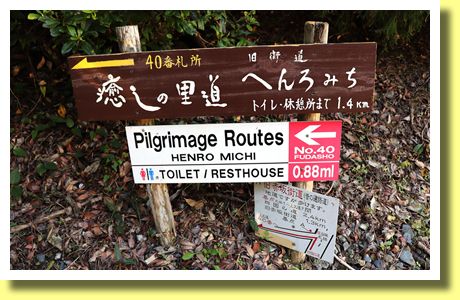
Unfortunately most of guideposts are written in Japanese. There are some written in English ( above ), but not so many. So pilgrims, who can not read guideposts written in Japanese, would need something helpful such as smartphones, tablet computers and/or tourist maps.
Pilgrimage Support App "Henro no Akari Shikoku 88 Temples Pilgrimage", downloaded on App Store / Google Play ( Free of charge ), could be helpful.
|
|
Sutras
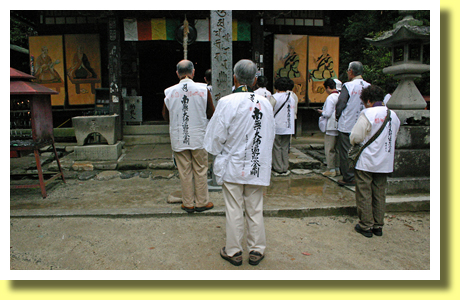
Upon arriving at each of the temples, most of pilgrims recite sutras in front of its main hall ( above ) and other halls while some pray silently. Then pilgrimage booklets could be stamped and signed at its administration office of the temples, though not necessarily.
|
|
National Treasures
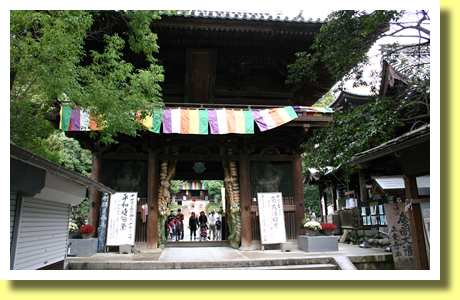
Though there are some structures built with reinforced concrete, there remain many old buildings in the sites of the 88 temples. So Shikoku Henro pilgrims would see many designated National Treasures and National Important Cultural Properties of Japan such as Nio-mon Gate ( above ) of Temple No.51 Ishite-ji, located in Matsuyama City, Ehime Pref. The gate was built in A.D.1318.
|
|
Seasons

In spring, pilgrims could see Sakura ( cherry blossoms ) in the sites of the temples. In autumn, there would be red leaves along Henro paths. In winter, temples covered with snow would be beautiful. The above photo shows a pilgrim walking in snow up to the main hall of Temple No.43 Meiseki-ji, located in Seiyo City, Ehime Prefecture.
However most of pilgrims visit temples in March-May and/or October-November because of moderate weather and comfortable temperature. In December-February, it could be snowy and freezing especially in mountains. In June, it would be rainy almost everyday. In July-September it would be too hot to walk around.
|
|
Sightseeing Spots

Shikoku Henro Pilgrims would have opportunities to visit sightseeing spots located near the 88 temples such as Uwajima-jo Castle ( above ), which is located in Uwajima City, Ehime Prefecture. Two of the 88 temples are located in the city. There are castles, shrines and some more sightseeing spots around Shikoku Henro Pilgrimage courses.
|
|
Local People

The lives of local
people living in the countryside of Japan are different from those in big cities. The above photo shows an old woman living near Temple No.45 Iwaya-ji, located in Kuma-Kogen Town, Ehime Pref. Pilgrims, especially those walking around, would have occasions to see how local people live.
Local people could sometimes give O-Settai ( alsm ) such as mandarins, manju ( Japanese-style buns stuffed with bean paste ), tea and so on to pilgrims, especially to those walking in white vests/jackets which help local people recognize Shikoku Henro Pilgrims walking.
|
|
Henro Yado
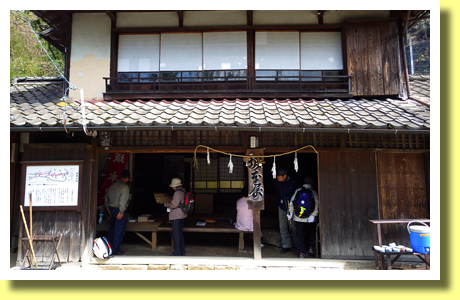
Until the mid-1920's, almost all of pilgrims walked to visit the temples. So they needed so many Henro Yado ( accommodation facilities for pilgrims ) along the old Henro Pilrimage Paths. Sakamoto-ya ( above ) used to be one of Henro Yado located near Temple No.46 Joruri-ji and Temple No.47 Yasaka-ji.
Now Sakamoto-ya, which is not Henro Yado any more, is open a few times a week through spring-autumn between 09:00 am - 03:00 pm to offer O-settai to pilgrims, who could take a rest with cups of tea. Henro Pilgrims would find such facilities achi-kochi ( here and there ) in Shikoku Region.
|
|
Landscapes
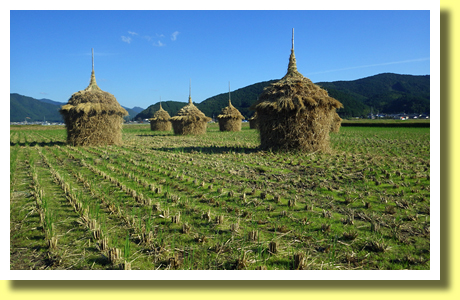
On the way to the next temple, pilgrims could enjoy viewing landscapes which tourists can not see in big cities such as Tokyo, Osaka, Nagoya and so on. In Shikoku Region, there are lots of landscapes such as paddy fields after the harvest in autumn ( above ).
|
|
Specialties
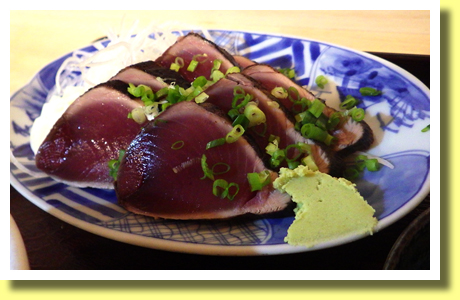
In Shikoku Region, there served are not only Sanuki Udon but also various kinds of local specialty dishes including unique seafoods such as Katsuo Tataki ( above ), which is slices of lightly roasted bonito served in restaurants in Kochi Pref. and in the south-west of Ehime Pref. Shikoku Henro Pilgrims would have opportunities to enjoy such specialty dishes in the region.
|
Copyright (c) 2021 Achi-Kochi Zanmai Co., Ltd.
|